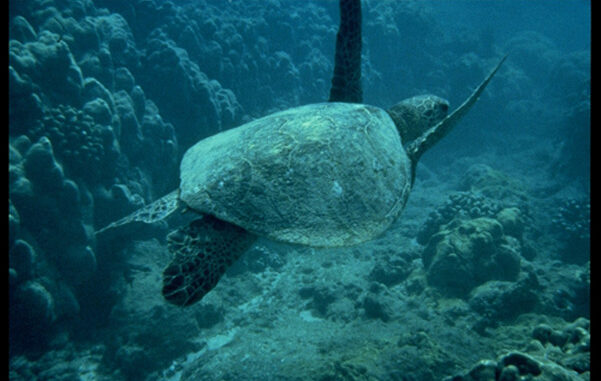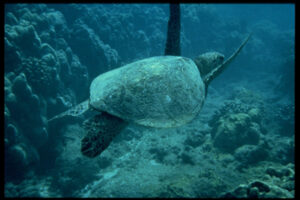

U.S. Fish &Wildlife Service/David Vogel
A green sea turtle
Though sea turtles have survived for more than one hundred million years, the remaining three species of sea turtles that return each year to lay their eggs on the Pacific beaches of Guatemala are endangered. Three key organizations are leading the fight to protect these remaining species: CONAP (National Council of Protected Areas), CECON (Center for Conservation Studies), and ARCAS (Wildlife Rescue and Conservation Association), and it appears that the sea turtles now have a fighting chance.
Monterrico Nature Reserve and Hawaii Park were established to protect the sea turtle eggs from locals who would sell the eggs to supplement their income. The tortugarios, or sea-turtle hatcheries, at these reserves have made an agreement with the local hueveros who come at night to wait while the mother turtles dig a hole in the sand and deposit their eggs. The hueveros, who are generally quite poor, still collect the eggs to sell to restaurants or at market, but now return one dozen eggs from each clutch to a hatchery. Conscientious visitors who witness the collecting of the eggs have been known to buy entire clutches of eggs from the hueveros and donate them to the hatcheries.
Monterrico Nature Reserve and Hawaii Park offer numerous programs for people who want to get formally involved in conservation efforts. Volunteers have the opportunity to seek out nesting green, olive ridley, and leatherback turtles and collect their eggs to bury at hatcheries run by CONAP, CECON, and ARCAS. After the eggs hatch—from fifty to seventy-two days later, depending on the species—the volunteers then release the baby turtles onto the sand so they can make their way to the water. The hatcheries are responsible for releasing thousands of hatchlings back into the ocean each year.
Visitors wishing to take a less hands-on approach can contribute to the conservation efforts by making a small donation to “sponsor” a baby turtle in its race to the sea. Every Saturday night from September to February, Monterrico Beach is filled with spectators cheering for the tiny creatures as they make their way to the ocean. Unaware of their adoring fans, the instinct-driven little turtles make the trek while forming the memories they will need to bring them back one day to this very beach to bury their eggs. Follow the link below to view a slideshow about sea turtles!
Explore More:
1. The names in Spanish of the three species of sea turtles in Guatemala are parlama blanca, parlama negra, and Investigate to find out which species corresponds with each English name.
2. How did sea turtles become endangered? It is estimated that only one in one thousand turtles make it to maturity, even though a mature female lays an average of a hundred eggs at a time. Research what threatens their survival.
Share What You Know:
1. See if you can determine the Spanish names for the following organizations: CONAP, CECON, ARCAS. You may want to return to the article to see what the English equivalents are.
2. Can you guess how the leatherback turtle got its name? After you decide on an answer, investigate to see if you were right.